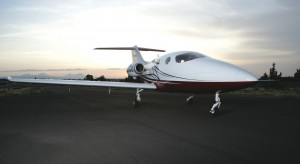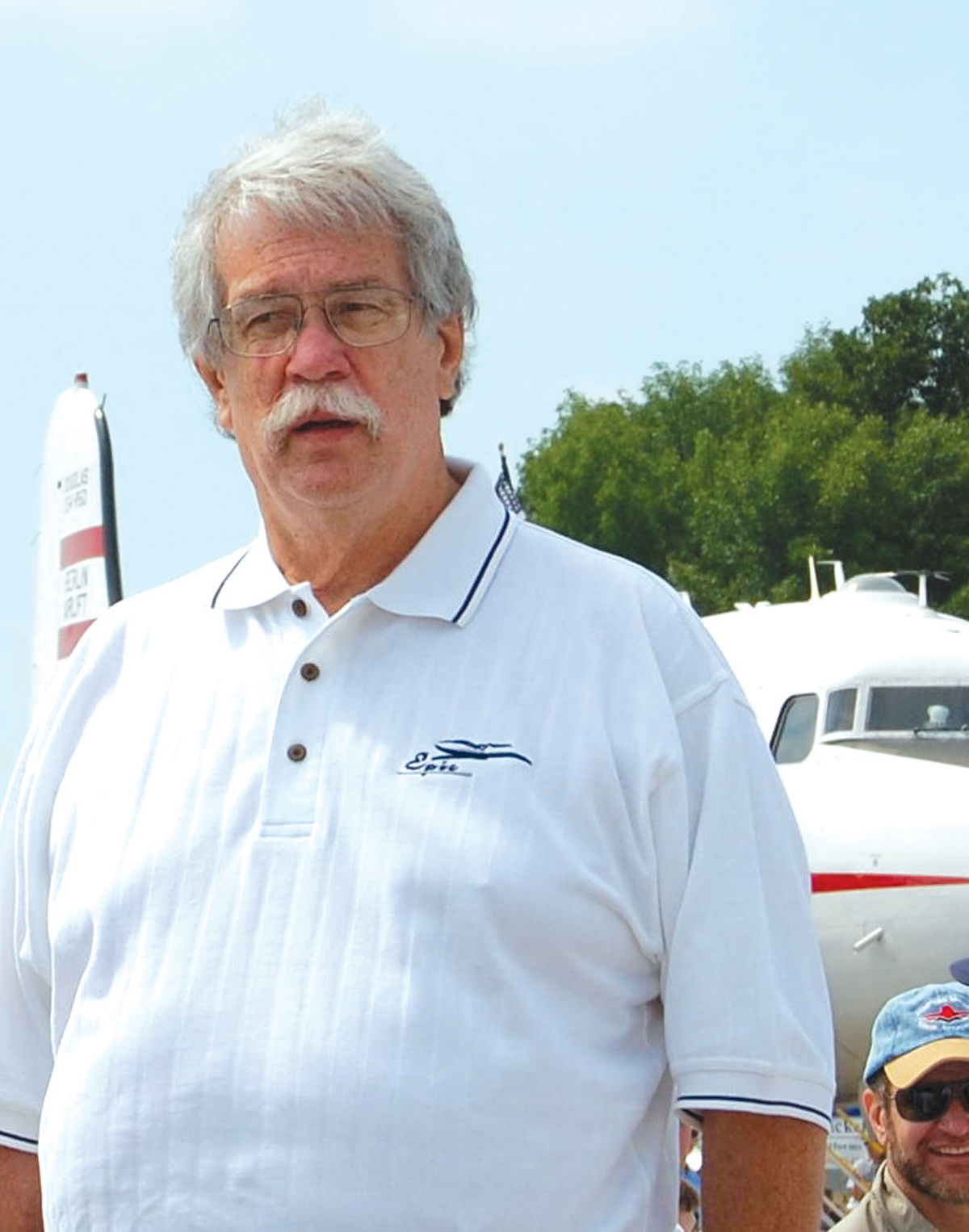
Epic Aircraft president and CEO Rick Schrameck said all of the company’s aircraft will be certified in Canada; the process is quicker and less expensive than in the U.S.
By Karen Di Piazza
“I’m a very proud papa,” beamed Epic Aircraft president and CEO Rick Schrameck, speaking of the Elite, a twin-engine very light jet. “This jet will absolutely eclipse anything else that’s out there, and that’s a promise!”
At dawn on June 7, Aircraft Investor Resources, LLC, parent company of Bend, Ore.-based Epic Aircraft, secretly rolled out its sleek-looking, all-composite Elite and conducted a flawless 40-minute first flight. Two Williams International FJ33-4A FADEC engines power the VLJ, configured to seat six to seven passengers.
EA said the Elite VLJ is headed for certification in 2009. Schrameck says the aircraft delivers 3,120 pounds of thrust and can reach 41,000 feet in less than 17 minutes.
“The economy cruise is more than 1,600 miles, with reserves that translate to 1,330 pounds of usable payload after fuel,” he said. “Our company motto is ‘fill it up, go the distance and leave nothing behind.”‘
Company test pilots Dave Morss and Len Fox pushed the aircraft’s control surfaces and low-level performance capabilities. Fox, who said he was reluctant to return, boasted that the jet actually flew better than expected.
“The Elite is just one of those aircraft,” Schrameck said. “The jet’s computer-designed fuselage allows the Elite to smoothly soar through the air, creating a minimum of disturbance and drag.”
He said the aircraft’s interior is pure luxury—the way it ought to be.
“Pilots will like the generous foot and shoulder room,” he said. “The field view from inside the Elite can’t be beat; no other aircraft offers this. Ergonomic-designed seats provide the pilots with comfort, as they’ll be in front of a cutting-edge cockpit—everything to provide safe, all-weather situational awareness.”
He said reclining, deep-cushioned, leather seats cradle passengers.
“The certified Elite will have multimedia options, custom cabinetry and a lavatory,” he said. “We’re pushing this jet to the upper tier of the VLJ market.”
On July 6, the company celebrated a second first flight with its Victory, a single-engine VLJ, seating up to five passengers. The flight lasted nearly 50 minutes, piloted by Fox.
“Considering that the Victory is a clean-sheet design, a mere seven months from conception, it’s an amazing feat,” Schrameck said. “We’re all very proud of what we’ve been able to accomplish with our family of aircraft.”
Presently in kit aircraft-form, both Elite and Victory cockpits house all-glass Garmin G900X avionics. Both aircraft will be certified to meet the compliant reduced vertical separation minimum.
“Who knows when Cirrus’ single-engine jet is going to fly, and the single-engine D-Jet isn’t going to be ready for a long time, but the Victory will be delivered to customers by year-end,” Schrameck said. “The Elite is really the first aircraft to deliver everything a VLJ is supposed to. I’d be happy to put the Elite up against anybody’s airplane. We’ve flown two new VLJs within 30 days. Can anybody else say that?”
Oshkosh is more than pipe dream for Schrameck

At dawn on June 7, Aircraft Investor Resources, LLC, parent company of Bend, Ore.-based Epic Aircraft, secretly rolled out its all-composite, seven-seat Elite, a twin-engine very light jet, and conducted a flawless 40-minute first flight.
In July, Schrameck proved that his promises weren’t empty. Both the Elite and the Victory debuted at this year’s Experimental Aircraft Association’s AirVenture in Oshkosh, Wis., with both jets landing smoothly at AirVenture’s AeroShell Square.
“When I say I’m going to do something, I do it,” Schrameck said.
Also making the trip to Oshkosh was the company’s popular Epic LT, the kit aircraft version of the Dynasty, its six-passenger, single-engine turboprop. The Dynasty is currently undergoing certification.
On July 23, EA awarded contracts to Pratt & Whitney Canada, which is part of publicly traded United Technologies Corp. P&WC’s PW617 engine will power the certified version of the Victory; the PW615 will power the kit aircraft version. P&WC’s PT6A-67 will power EA’s certified Dynasty, and the Elite will continue to use Williams International engines.
At this year’s AirVenture, Schrameck realized a historical moment for his company. Dr. Vijay Mallya, chairman and CEO of India’s Kingfisher Airlines, flew into Oshkosh on his personal Airbus A320 and consummated a deal with Schrameck to invest a significant amount of money into EA. The details of the deal weren’t made public. But EA announced that it did obtain $40 million in new aircraft orders during the event.
“This is one more validation that Epic Aircraft’s products are quality,” Schrameck said.
Things have certainly changed since AirVenture 2003, when high-tech businessman Schrameck sat inside his air-conditioned RV and showed people CAD drawings of a new airplane design. Most people ignored it when he said, “We’re going to change the way the aviation industry brings airplanes to market,” because they thought it was braggartism. Schrameck said he doesn’t have hard feelings.
“A lot of people show up at the event promising the moon,” he said.
The following year at Oshkosh, attendees looked up to identify the source of a roar in the sky. It was Schrameck flying his new 1,200-hp Epic LT turboprop.
Today, EA has many fans, including NASCAR’s “Million Dollar Bill” Elliot, who owns and pilots an Epic LT. Elliot and Schrameck love to talk about fast cars and racing. In fact, Schrameck has been racing cars since age 17, in everything from drag races to the Trans-Am 24 Daytona races. He even sponsored an Indy car.
“There are a couple of industries you can get hooked on: aircraft and cars,” he smiled. “Once they get into you, you’ll never be able to get away from them. In a previous life, I even owned a Ferrari dealership in San Francisco. I’m crazy about speed; I’m addicted to speed. As a youngster, I built a rocket-powered go-kart; looking back, it was a crazy thing to do. So you can see why I love our aircraft; I love the speed of the Epic LT at 340 knots. And I love our jets. I believe my father, who served as an Air Force pilot in three wars, genetically transferred his passion for aviation. ”
On a serious note, Schrameck reflects upon EA’s success.

On July 6, Epic Aircraft celebrated the first flight of its Victory, a single-engine very light jet that seats up to five passengers.
“We did a lot of research, and we couldn’t find another company that has demonstrated this kind of focus and commitment to bringing an aircraft from the proverbial drawing board to reality in this length of time,” he said. “Considering that the Victory is a clean-sheet design, a mere 28 weeks from conception, it proves that Epic Aircraft has the best engineers and manufacturing talent in the world.”
Schrameck says the Victory jet’s price is under $1 million. Following Epic’s business model of pre-certification, the Victory will first be available as an owner-built aircraft. Under the Federal Aviation Administration’s rules, customers of homebuilt planes are considered manufacturers, with a 51-percent stake in assembly. EA’s Oregon facility assists owners who build their own aircraft.
“Under the FAA’s 51-percent rule, we provide a great deal of guidance for our owners,” Schrameck said.
Looking ahead, he envisions EA producing 200 Elite jets a year, after the aircraft is certified.
“I’d consider that a success; we’re capable of producing 200 jets a year,” he said.
Certifying aircraft in Canada vs. the U.S.
Schrameck says he will certify all of EA’s planes in Canada.
“Speed is money; time is money,” he said. “I’m not a regulatory guy, but there are reciprocity agreements between countries for aviation certification. For instance, aircraft that are certified in Europe or Canada end up certified in the U.S. It’s not automatic, but those regulatory bodies and the FAA have very good working relationships.”
He said that unlike the U.S., when aircraft become certified in Canada, they’re certified as ready to fly passengers.
“Canada’s certification process means you don’t obtain some temporary, provisional-type certification,” he said. “With Canada, aircraft have to pass all the tests before they’ll issue a certification. Our aircraft will be useable from the day they’re certified. That’s extremely important. There are issues when a company says, ‘I’m certified,’ when the aircraft can’t actually be delivered as a useful airplane.”
At the end of 2006, Schrameck said the company had 20 aircraft in its factory under various stages of construction. During Sun n’ Fun this year, the company sold $23 million in airplane orders. Rather than go out and raise millions of dollars trying to produce aircraft and go for “traditional” certification, Schrameck says it’s the experimental aircraft sales that fund the certification program. He said it makes sense to go about the process that way.
“There are many reasons to go from experimental to certified aircraft,” he said. “One reason is that you’ll have a lot of planes out there; that provides valuable feedback from customers, marketing data and a lot of flight hours. And by doing so, you don’t have to build say, two, three or up to five prototypes. Also, in the U.S., an aircraft manufacturer might have to select its avionics several years before the aircraft finally completes certification. Consequently, it’s a risk of having a new airplane with less than cutting-edge electronics. In Canada, we can select and test the avionics later in the certification process. The Dynasty and all our aircraft will have state-of-the-art avionics. You can count on that.”
Why aren’t more aircraft manufacturers starting with experimental aircraft and then moving to certification in Canada?
“It’s the same reason online movie rental businesses became successful,” he said. “While other movie rental places depend on walk-in traffic, the guy who came up with a simple way to get movies to you via the mail dominates the market. It’s the same thing for aircraft here in the United States: no one thought of it. It’s not rocket science, it just works.”
In addition to the company’s manufacturing facilities in Oregon, EA’s Canadian division will include a 100,000-square-foot manufacturing plant outside of Calgary, Alberta, and a 50,000-square-foot certification facility in a joint effort with the Canadian Centre for Aircraft Certification. This is just the beginning for EA. If all goes well, Schrameck says the company plans to expand its manufacturing capabilities.
“Epic Aircraft is here to stay,” he said.
For more information, visit [http://www.epicaircraft.co].











